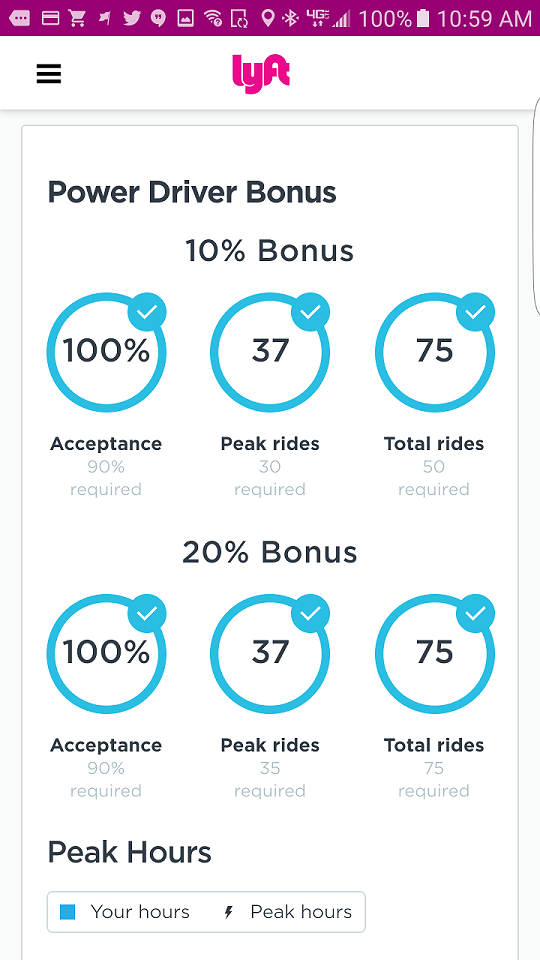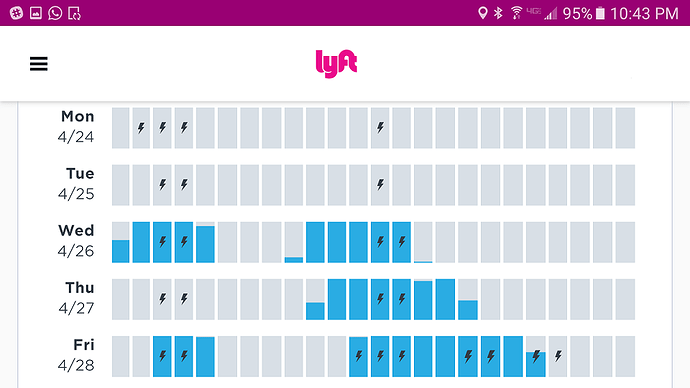Lyft just finished a $1 billion investment and really ramping up the works. Lyft reached over a million rides a day serving over 95% of the US. They are increasing their market share on a gradual yet exponential increment and now, after four years of strict competition with Uber, have passed their 100 million rides per annum and are now at 100 million rides in three months. A lot of drivers used to work for both Uber and Lyft, but now quite a few are moving over to Lyft since they discovered the power of the Power Drive Bonus plan that Lyft offers its drivers.
What is Lyft Power Driver Bonus (PDB)?
Lyft has a special reward system in place that pays drivers more income based the number of rides performed within a peak hour and normal hour range over the course of a week. The payback can be worth quite a lot of money in some cities and in others are a set amount.
Basically, drivers must meet all PDB requirements to get additional earnings. The PDB is reset every week, and the qualifications are reset too, so a driver might not qualify for a week after week PDB. PDB is not available in all cities, and drivers know of its availability when receiving an e-mail. If a driver doesn't get an e-mail it doesn't mean that he is not eligible for the PDB, it just means that there aren't any that week. The status of a drivers PDB can be viewed on the driver dashboard, that way a driver can see how they meet the requirements during the course of the week.

To qualify for PDB a driver must be in a region where it is available, the car used must be newer than a 2011 model, and if a driver doesn't own one, then at least 50% of all the rides driven per week must be in such a model. The number of rides in the dashboard must be met, and the acceptance rate has to be over 90%. Lyft line rides are also calculated as rides for the requirements. So, if you took two separate Lyft Line rides, then you completed two rides per the PDB requirements. Peak rides are given during high saturation times, busiest times of the day, and these are called peak hour rides. This means that Lyft needs more drivers on the streets than usual to be able to take the load of a highly saturated demand market. Peak rides, as per the PDB requirements are rides taken during peak hours, and these hours change between cities. Peak hours are not to be mistaken for prime time or guarantees; they are not.
PDB is calculated one a week, usually on Monday's at 4:59 am and restarted on Tuesdays.
Some cities have tiers; these are preset bonuses rather than a percentage of income. The big difference between the two is that a percentage of income can return a lot of Lyft's commission to the driver, whereas the tier PDB is a set amount, such as $50 or $100. Requirements for tiers vary too and usually include a mix of acceptance rate, peak, and normal hour rides.
As a Lyft driver, I have succeeded in attaining PDB status every week. I used to work for Uber, but in 2016 moved over to Lyft and ever since Lyft made a better PDB system, adding prime time and guarantees, driving for Lyft is now proving to be more lucrative than driving for Uber.
Key Performance Indicators (KPI)
Lyft uses four Key Performance Indicators (KPI) to evaluate the eligibility and results; The first KPI is the hours you drive during the week, for instance, if you drive 30 hours they will only take a 10% service fee from your fares and if you drive 50 hours you don't pay any service fee, so you get to keep all the income you make on the ride.
The second KPI is the number of logged in driver hours you have, which is recorded down to the minute.
The third KPI is the number of rides you take during peak hours. Usually, you have to log in at least 10 peak hours per week to qualify for the PDB.
The fourth KPI is your acceptance rate, and it must be above 90%. This means that you cannot accept and cancel rides as you might like to, it also means that you have to work properly during the hours you do work.
Calculations
The 20% income what Lyft takes from the fare (is saved rather than paid out to Lyft) can come to over $400 a week, which means $1,600 a month. Usually, if you manage to get PDB status monthly, then you should maintain a 50-hour week and ride the wave of success. Here are some numbers from my dashboard.
I manage to maintain a minimum of 55 rides per week, and usually, I am over 60. My current stats show these numbers. Hours Worked: 32, Peak Hours: 15, Ride Payments: $750, Tips: $65 and Power Driver Bonus: $150. This was a weak week since I usually drive more than 40 hours a week, but that particular week I had some personal family issues to deal with. Even with them, I managed to raise my income considerably.
Here is a more in-depth calculation, based on a 50 hour week.
Earnings
| Day | Trips | Ride/tip | Lyft Fees | Your Earnings |
|---|---|---|---|---|
| Oct 23 | – | – | – | – |
| Oct 24 | 1 | $5.30 | $1.06 | $4.24 |
| Oct 25 | 3 | $59.27 + $5.00 | $11.84 | $52.43 |
| Oct 26 | 7 | $70.17 + $9.00 | $14.01 | $65.16 |
| Oct 27 | 12 | $147.00 + $12.00 | $29.38 | $129.62 |
| Oct 28 | 21 | $193.51 + $17.00 | $38.65 | $171.86 |
| Oct 29 | 8 | $103.30 + $14.00 | $20.64 | $96.66 |
| Totals | 52 | $578.55 + $57.00 | $115.58 | $519.97 |
| Time in driver mode: | 51 hrs, 30 min |
|---|---|
| Ride payments: | $578.55 |
| Lyft fees: | – $115.58 |
| Tips: | $57.00 |
| Passenger cancelations (3): | $15.00 |
| Other | $107.95 |
| Power driver bonus (20%): | $115.58 |
| Your earnings: | $758.50 |
Tips for increasing your PDB
Tip # 1: Work more than 40 hours
If you cannot work long hours, then don't bother trying to get into the PDB program. The PDB system is fueled by more work generating more income.
Tip # 2: Work more peak hours
Peak hours are usually rush hours, such as the early morning, driving people to work and weekends, when there are many peak hours for Friday nights and Saturday's.
Tip # 3: Accept every ride
Don't be choosy, accept every ride, go for a 100% acceptance rate. This will boost your metrics all the way up.

